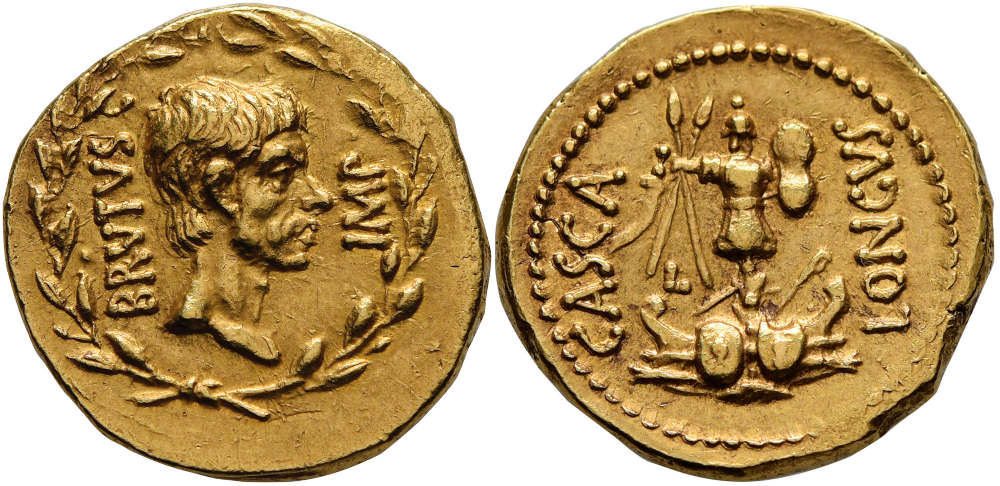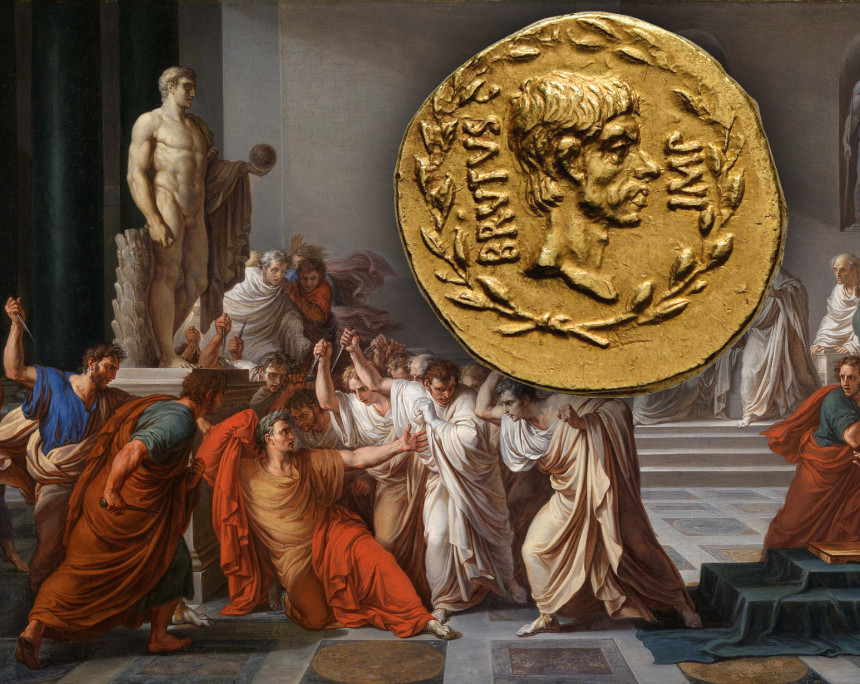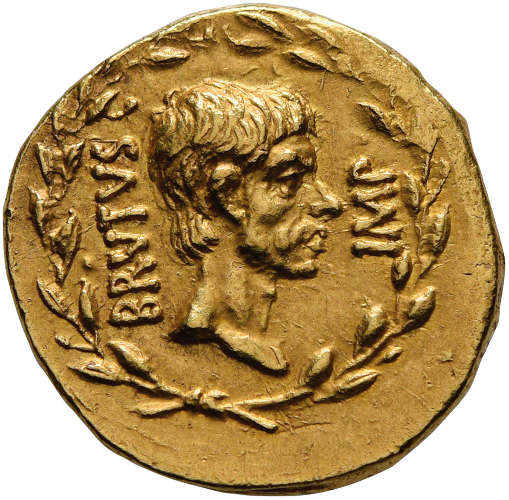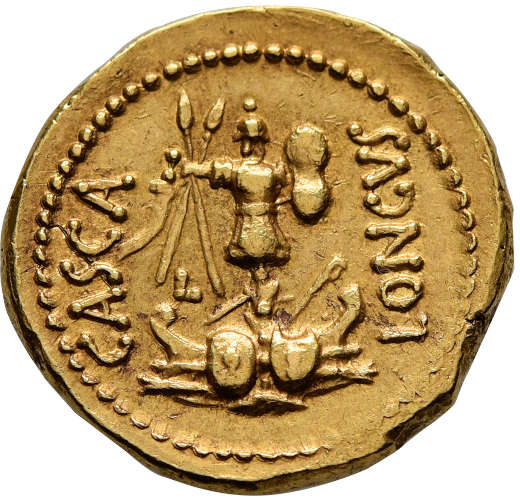The Eve of the Battle of Philippi: An Aureus Featuring the Portrait of Brutus
by Ursula Kampmann on behalf of NGSA, translated by Rachel Agard
On 9 December 2024, Numismatica Genevensis will be auctioning an extremely rare aureus featuring a portrait of Brutus. The coin, estimated at CHF 750,000, was minted to pay the soldiers who fought for Brutus in the final battle at Philippi.
Content
As Trivulzio once reportedly told the French king, there are three things one needs for warfare: money, money, and yet more money. This is also something that Caesar’s assassins clearly understood all too well. By 28 November 44 BC at the very latest, they must have realised that the possibility of a peaceful new beginning for the old Republic was out of the question. On that day, under the command of Consul Marcus Antonius, the provinces were assigned to new governors. Of course, only his own supporters were favoured in this process. Brutus and Cassius, on the other hand, lost their positions as governors of Crete and Cyrene respectively. Not that this would really have mattered, since neither of the experienced politicians had actually gone to their respectively provinces anyway. They travelled instead to wealthier provinces, where there was enough gold to finance an army.
The Assassins’ Treasury
Immediately after Caesar’s death, the supporters of the old Republic started collectively raising the funds they needed to go to war. To manage this war fund, Cicero turned to his friend, the financier Atticus. However, he refused, unwilling to embroil himself in such a complicated matter. Instead, he remained neutral. And this decision certainly paid off for him; Atticus was among the small number of Cicero’s friends who continued to play a prominent role under Augustus’ rule.
Anyway, the problem of the war fund still remained. So, Brutus found a way to solve it that also served his own interests: he decided to manage the fund himself. To raise more wealth, he travelled to Macedonia, where one of his relatives held the office of governor. There, in the middle of 44 BC, the Quaestor of the province of Asia presented him with 16,000 talents – an enormous sum! The talents were used to mint 90 million denarii, which was enough to build and finance an army. And so within just a few weeks, Brutus was able to assemble seven or eight legions, which he used to take control of northern Greece. Now, he could report to Rome that Macedonia and Illyria were in the hands of the Republic (i.e. his own). Since Cicero controlled Rome and therefore the Senate (until the unfortunate end of the War of Mutina in April 43 BC), he ensured that Brutus’ position was officially confirmed.
Asia Minor Is Plundered and the Thracians Are Invaded
This meant that Brutus – just like Cassius in Syria – had the power to impose taxes. Roman officials were allowed to set taxes at their own discretion, which essentially meant they had a license to plunder. And 16,000 talents was nowhere near enough for Brutus.
The problem faced by Pergamon, Ephesus, and all the other province capitals was that it was not just Brutus demanding their money, but his opponents as well. For example, Pergamon paid 50 talents to Dolabella, only to be punished following the latter’s defeat with a further contribution of 200 talents. The people of Pergamon did their best to raise this money. After all, they knew what Cassius had done in Tarsos: after demanding a contribution of 1,500 talents from the city as punishment for allowing Dolabella to shelter within its walls, he first took control of all the city’s public and private funds. Then, when that was not enough to cover his demands, Cassius ordered the precious metal from the temples to be melted down and made into coins. When that still was not enough, he started selling the city’s people into slavery; first the young men, then the girls, women and fathers, and finally even the elderly. But the amount of money this raised still fell far short of the sum he had initially demanded. Cassius had no other choice but to forgive the city’s remaining debt, because he simply could not squeeze another quadrans out of it.
But there were other options. An official position not only gave one the right to impose taxes, but also to wage war. And a well-calculated war could be very lucrative indeed. So, Brutus invented some flimsy reason to march into the gold-rich region of Thrace. And it was certainly worth his while; he seized, among other things, the royal treasure of Sadalas II, as well as a huge pile of golden vessels, which were used to produce magnificent aurei.

Marcus Junius Brutus and Publius Servilius Casca Longus. Aureus, minted in late summer or autumn of the year 42 BC, military mint in Asia Minor or northern Greece. IMP / BRVTVS Portrait of Brutus in a laurel wreath to the right. Rev. CASCA / LONGVS Tropaion, consisting of armour, helmet, two spears and a scimitar, as well as a shield shaped like a figure of eight. The tropaion rests on the prows of two ships. Cr. 507/1b (same die). Mazzini 14 (this specimen). Sydenham 1297 (same die). From the Giuseppe Mazzini (1883-1961) Collection, volume 1, plate 5, 14. From NAC auction 34 (2006), 3. Only 17 specimens known. NGC AU* 5/5, 4/5 (2157714-010). Extremely fine. Estimate: CHF 750,000. From Numismatica Genevensis auction 20 (2024), No. 1032. Photo: Lübke + Wiedemann KG.
Dating the RRC 507 Aureus With Brutus’ Portrait
In fact, Cassius Dio 47.25.3 tells us that the coins with Brutus’ portrait were themselves minted from the Thracians’ gold. He also links them to those depicting the Phrygian cap between two daggers. However, Cassius Dio, who was not born until around two centuries after the Battle of Philippi, may have dated the coins incorrectly. The Brutus portrait is always accompanied by the title IMP[erator], and could therefore only have been created after this title was adopted during the meeting in Sardis in the summer of 42 BC.
This means that all the aurei featuring Brutus’ portrait are linked to a highly unusual event: as recorded by Appian IV, 118, Brutus paid his soldiers a large allowance before they fought in the Battle of Philippi.
Gifts of Money Before the Battle
Shortly before the battle, Brutus gave each legionary an incredible sum of 1,500 denarii. The immense value of this payment is illustrated by the fact that, after the death of Augustus, the legionaries demanded a daily wage of one denar. 1,500 denarii would therefore have been equivalent to more than four years’ wages.
Brutus’ army reportedly comprised 80,000 legionaries and 20,000 horsemen, as well as auxiliary troops. The sum he paid out to the 80,000 legionaries alone amounted to 120 million denarii. He also gave out money to the other troop units, as well as higher payments to the centurions and legates. Producing and distributing all these coins would have been a huge logistical undertaking, which was greatly simplified by minting aurei instead of denarii. After all, one aureus was worth 25 denarii.
Four legates were appointed to oversee the minting of the coins. M. Servilius was appointed to represent Cassius, while Brutus was represented by the officials Costa, L. Plaetorius Cestianus and Casca Longus. The minting operation was coordinated centrally and precisely. The portrait of Brutus played a key role in the issues produced by all three officials.
Casca Longus and the Portrait of Brutus
Let us take a look at the coin that was minted on the orders of Brutus and under the supervision of Casca Longus. Its obverse depicts the portrait of Brutus with the inscription BRVTVS IMP; his head is encircled by the laurel wreath of Apollo to symbolise that the god had assisted Brutus in his victories.
The reverse depicts a remarkable tropaion. It rests on the prows of two ships, to illustrate that Brutus was not only powerful on land, but also had a strong fleet. This fleet was manned by the Rhodians and the Lycians, who had been subjugated by Cassius and Brutus respectively in the early summer of 42 BC.
The reverse also features the name of the official responsible: Publius Servilius Casca Longus. This official was also involved in the assassination of Caesar; in fact, according to Plutarch, it was he who delivered the first stab. In December 44 BC, the Senate, influenced by Cicero, made him Tribune of the People. But after Cicero was defeated in the War of Mutina, Casca fled to Macedonia to join Brutus. There is no further record of him after the Battle of Philippi.
An Extremely Rare Piece That Holds Great Historical Significance
The coin to be auctioned by Numismatica Genevensis therefore holds a great deal of historical significance. It reveals how confident Brutus and Cassius were of victory before their battle against the Caesarians. However, it also bears witness to how little trust Brutus had in his soldiers. He had to buy their loyalty. None of them were interested in pompous slogans about freedom.
And so it was not Brutus who won the battle, but the Caesarians. Their undisputed leader was Marcus Antonius, who had also given an inspiring speech to the legionaries before the battle. In this speech, he did not promise them any gifts of money. He would not have had the means to pay them. Instead, he promised them that, after their victory, they would be allowed to loot the enemy camp for gold and food – which they did, by the way.
This is exactly the reason why there are so few coins with the portrait of Brutus remaining today: of course, the victors of the battle withdrew them from circulation and melted them down. The resulting precious metal was then used to produce all the coins with which Augustus flooded the Roman Empire.
By contrast, only 17 specimens of the Casca aureus with Brutus’ portrait still remain today.
Brutus: Committed Democrat or Just Another Member of the Roman Aristocracy?
Perhaps it is precisely because of their rarity that the coins with the Brutus portrait have become an icon of numismatics, a symbol of freedom. This may come as a surprise. After all, one of the reasons why Caesar was murdered was because he broke the taboo of depicting his own portrait on coins like a Hellenistic prince. Was Brutus now, just two years later, using his own portrait to hint that he had similar plans?
Certainly not. Rather, in the short time between the Ides of March 44 BC and the summer of 42 BC, using one’s own portrait as a coin motif had become an established practice. Everyone was doing it now: Marcus Antonius, Octavian, Lepidus, Sextus Pompeius. Incidentally, the earliest Brutus portrait is not found on the coins commissioned by Brutus himself, but on a coin produced in Rome. Mint master L. Servius Sulpicius Rufus, whose family sided with Cicero and thus with Brutus, depicted Brutus on his coins – without naming him and probably without his knowledge.
Nevertheless, Brutus must have thought of Caesar often. Since November 44 BC, he had found himself in a similar position to Caesar before he crossed the Rubicon: the Caesarians had robbed him of his position in society, and if he wanted it back, he had have to fight for it. But unlike Caesar, he did not win; his enemies did.
The fact that Brutus is regarded today as a champion of democracy and freedom has nothing to do with him as a person or even his politics; it is because the rebellious Dutch Republic used his coin designs as a symbol of its own struggle for freedom.
Ultimately, neither Brutus nor the Dutch were really fighting for freedom at all, but for their own interests – but that is a whole other story.











